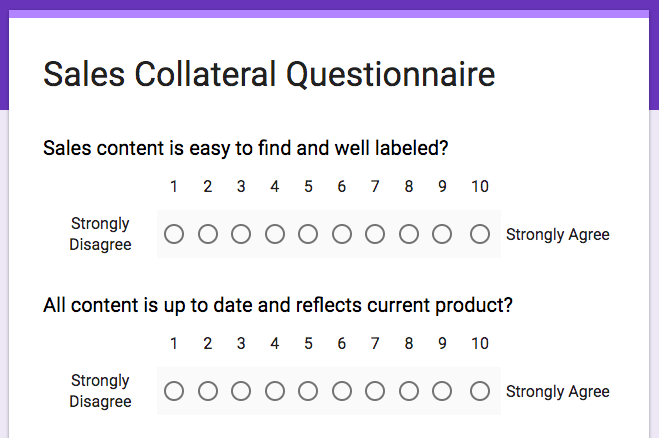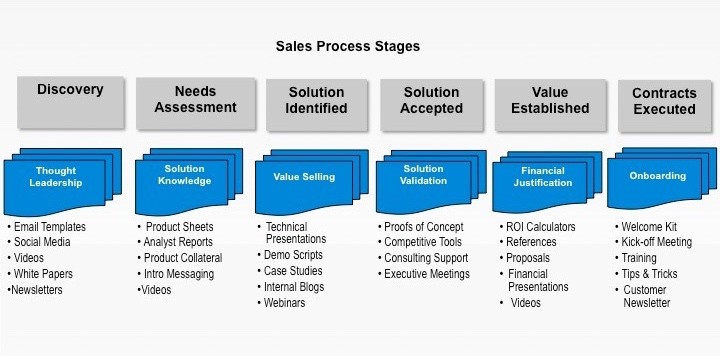A content audit isn’t sexy. It’s not a growth hack. This post isn’t going to give you one weird trick to crush your quota.
It’s easy to get caught up in the promise of quick wins — under constant pressure to achieve faster and faster growth, we’re all looking for that next breakthrough. The easier and faster, the better. And the world of sales and marketing content is quick to respond, promising tenable hypergrowth at the bottom of every listicle. The reality though is that stringing together “hacks” doesn’t lead to sustainable, nor long term revenue. You need a real go-to-market strategy, and smart processes to reinforce it.
A content audit is one of those smart processes. They’re not fun; they aren’t exciting, but when deployed properly they can significantly impact sales and marketing outcomes. When deployed often, they can become a pillar of well-functioning sales and marketing teams. At DocSend, we’re fortunate enough to work with world-class sales and marketing organizations that deploy content in a truly artful way.
Here’s a rundown on how to execute a content audit based on our own experience, and what we’ve learned from these clients. Every sales team is different. With that in mind, I’ll walk through tactical advice, but try to stay at a level from which you can easily extrapolate to create a process that works for your team.
What is a content audit?
A content audit is a strategic review of any and all content used by a sales team throughout the sales process, with a specific goal in mind. A content audit maps your sales content against your sales funnel, and surfaces areas where investment in content can have the largest business impact.
It is not a hygienic exercise. The output of a successful audit should equip you to make an informed investment decision by highlighting quantified opportunities, leaving you to evaluate them against their production cost.
Phase 0: Get a lay of the land
This is table stakes, but the pre-work for any successful content audit is to first consider your company’s top-level goals. Then make sure you intimately understand how the goals of your sales and marketing team support those initiatives.
RELATED: Sales Enablement Content: How to Give Reps What They Truly Need [Infographic]
Consider how sales content can facilitate achieving those. For example, let’s say the company has a specific revenue goal. Your sales team knows that the easiest way for them to hit that is to increase the opportunity creation rate by X%.
Start thinking about what role content can play at that specific deal stage.
Phase 1: Talk to Sales
Before you go off cataloging every last white paper and building out a content production calendar for the next six months, start by talking with your sales team about their biggest concerns with sales content.
You probably think you know this already — and that’s great. You know the ins and outs of the sales process, and you have a solid hypothesis on content problems and opportunities.
If that’s the case, then this step is even more important because your assumptions need to be validated, or broken down, if you’re going to make a real impact.
In these discussions, you’re looking for feedback on your content library along the following dimensions:
- Organization: How easy is it for sellers to find the right piece of content when they need it?
- Impact: Do reps feel the content they have moves deals forward?
- Freshness: Is sales content up to date, and reflective of the current product?
- Coverage: Is there adequate content for every deal stage?
- Relevance: Is there content that every major customer segment can identify with?
Talk to sales management to get a high level read, but make sure that you also talk to individual AEs and SDRs. They’ll have the best sense of what actually is and isn’t working. In terms of volume of conversations, five tends to be a magic number when doing customer need-finding, and it tends to work well here too. Less than that and you risk bias and may not see trends, more than that and diminishing returns quickly set in.
Work for a team of hundreds or thousands of sellers? Take the top five to ten trends you saw in those conversations and send out a brief survey to the rest of the team to validate that the same holds true across markets.

Phase 2: Set a goal
Before embarking on the audit, set a clear goal. Like any cross-departmental project, a content audit can quickly become a rabbit hole. Get in front of that by setting a clear goal early on in the process. Large teams with complex sales processes and deep content libraries need to be especially careful to avoid boiling the ocean.
Here are some examples to keep rails on the project:
- There are a few trouble spots in the sales funnel. You want to identify areas that content can help.
- Lots of content is outdated and off-brand, but you don’t have the resources to re-do everything. You want to figure out what’s worth the investment to update.
- The content library is completely disorganized. You want to understand what reps are using and how so you can reorganize it to better suit their work style.
- D.) All of the above. Let’s rumble.
Once you have a goal in mind, put a number on it.
If it’s to support your sales funnel, a key result could be to increase the rate at which opportunities move from stage 1 to stage 2 by 25%. If the content is outdated, set a goal that 80% of content used next quarter is up to date. If you’re trying to solve the organization, set a goal that 90% of reps on your next survey agree that content is easy to find.
It’s also helpful to set a time-bound for when you expect to see these results. Otherwise, you risk waiting and waiting to measure your impact, or never revisiting at all. As soon as you’ve agreed to a timeline for results, set up a calendar invite with your stakeholders for a post-mortem to give yourself a real deadline.
Phase 3: Map the world
Identify all content that gets used throughout the sales process and maps it against your sales funnel. If you’re using a sales content management system, this is easy as you’ll already have a repository of production content — including what individual reps have created and sent on their own.
If, like many organizations, your sales content is strewn across a mishmash of Google Drive, Dropbox, Slack messages, and individual reps’ hard drives… you’re going to have to get creative.
You can do the obvious, like manually combing through shared drive folders. If you identified that reps are frequently creating their own collateral, it might be worth a mass email asking sellers for the last 10 pieces of content they sent to prospects. If you have detailed email logging in your CRM, you may be able to search activity history for keywords like attachment, white paper, case study, etc.
Every sales team has different deal stages and content, but here’s what this should look like at a high level:

Source: The Value Shift Blog
Tactically, while it’s tempting to show off your PowerPoint skills, it’s easiest to do this in a spreadsheet. Start with the following columns:
- Deal stage
- Content title
- Link to content
Phase 4: Score your content
The goal of this phase is to create a rubric and then evaluate your content against that. What goes into the rubric should be entirely driven by your audit goal. For example, if your audit goal is to ensure you have effective case studies for every key vertical, you may just need three columns — content type, persona, and content utilization (whether or not Sales is actually using it).
Here are some other parameters that can be useful to score against:
- Is this piece of content on a brand?
- Format (PDF, video, deck, etc.)
- Deal stage
- Date created
- Last updated
- Sales use case (leave behind, etc.)
- Persona / Buyer Type
Sales content management platforms like DocSend can show you how the sales team is deploying content, and tie it back to the CRM so you can measure how content is impacting deal progress. These can be critical inputs at this stage, depending on your goal.
Add these as columns to the content map you created. Review and score each individual piece of content. Remember to limit scope wherever possible. Your audit goal should act as a filter in this stage. For example, if you’re strictly trying to improve proposal to close rate, you can ignore top of the funnel content entirely.
Phase 5: Identify opportunities and make a plan to address them
At this point, the content audit is complete. By reviewing the content map you created, you should clearly understand what your content library looks like and how it’s being deployed by sellers. Look for patterns of how the content you scored stacks up against your audit goal, and identify the biggest opportunities to improve.
The path forward from here is an investment decision, where you’ll want to evaluate the potential upside of creating a project to fill those gaps versus the cost it will take to execute it. If the project is as simple as re-organizing, the cost may just be time. If the output is needing to do a major overhaul of every case study, or produce a series of video assets, the cost may be material and you’ll want to evaluate that appropriately against your other strategic initiatives.
Phase 6: Measure the impact
After months have passed and you’ve executed the projects that resulted from your audit, you should review the KPIs you set out to affect. Validate your hypothesis and impact. Did the output of your audit and content plan have the impact you expected? Why or why not? Dive in and figure out what you can do better next time, both when producing content, and in the actual audit process itself.
Maybe there was an assumption in the survey you sent out that skewed the results, or maybe the scoring framework you built didn’t align with your audit goal well enough. Whatever the case, it’s always worth going back and figuring out how you can be better next time.
Phase 7: Do it again
Content audits provide the most value when they’re made a regular process. As you perform them quarterly, or yearly, you’ll start to identify high-level trends that can be extremely valuable. For example, if you find yourself solving organization and freshness issues quarter after quarter, it’s likely that something fundamental to your operating model is leaving room for content to go stale and you should look at investment in technology or process to address it.



